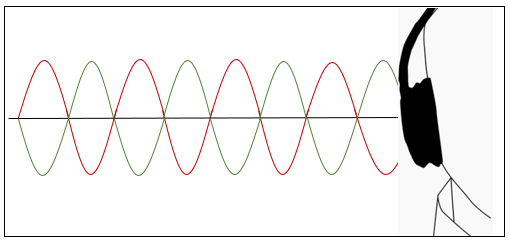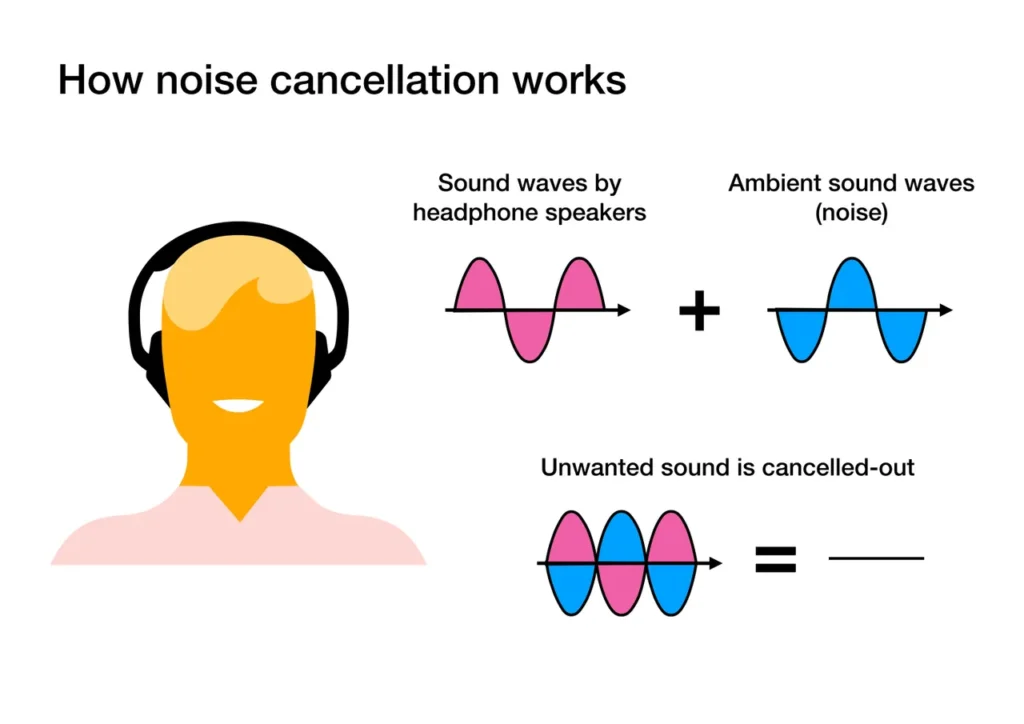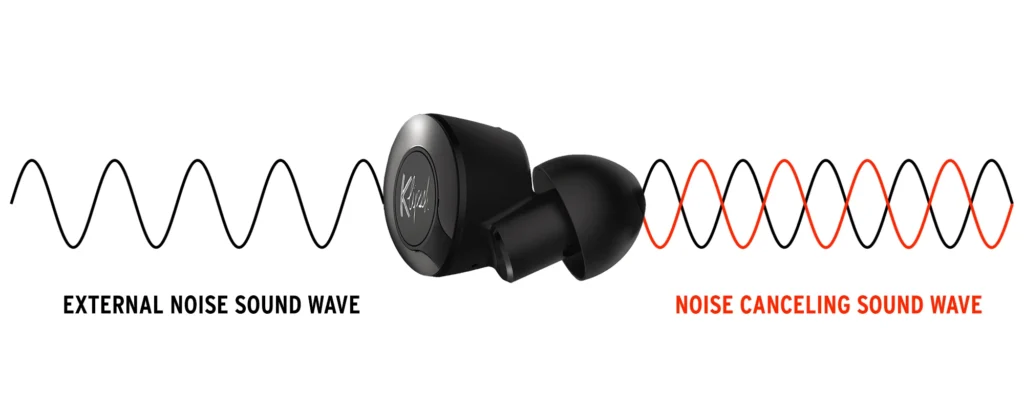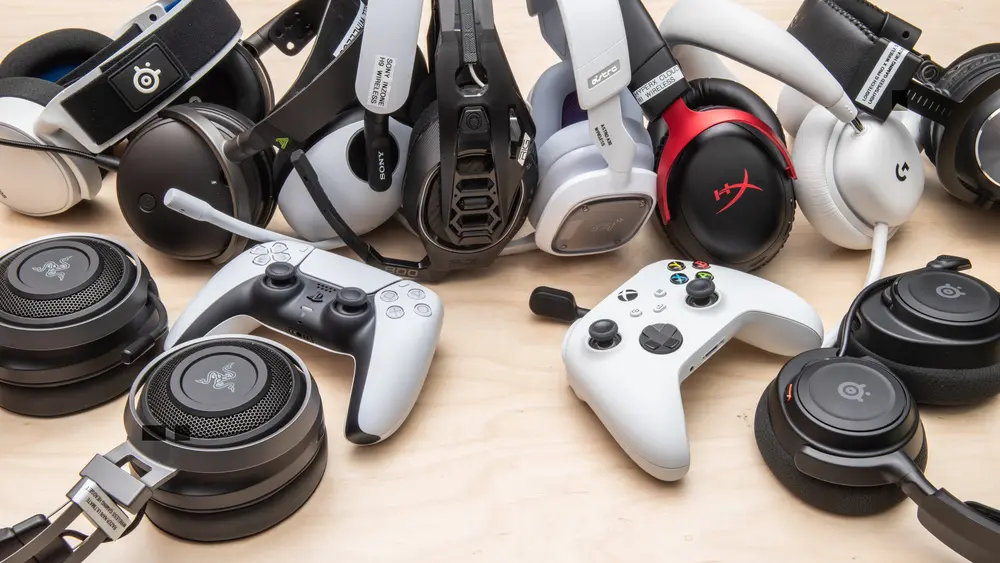“NC” stands for noise cancellation. You’ll see it on packaging and in product names, usually when a headset or pair of earbuds offers some way to reduce outside noise. Sometimes it refers to active noise cancellation (ANC), and sometimes it just means passive isolation. The term is used loosely, which can be confusing if you’re trying to compare models.
Table of Contents
I’ve seen brands use NC to describe everything from basic over-ear headphones with tight ear pads to advanced systems with microphones and signal processing. So when you see “NC,” it’s worth checking what kind it actually is.

At its core, noise cancellation is just any method that helps you hear less of what’s happening around you. That can mean blocking noise physically, electronically, or both.
Passive Noise Cancellation (PNC)
Passive noise cancellation doesn’t use batteries or microphones. It’s just about the physical barrier between your ears and the world. Over-ear headphones with thick memory foam pads usually block more than lightweight on-ear models. In-ear monitors with silicone or foam tips can also create a tight seal that blocks a surprising amount of outside sound.
I tested a few closed-back models recently, including some studio-style headphones that didn’t have ANC at all. But with deep ear cups and thick clamping force, they still managed to block the hum of a fan and low chatter in a shared workspace. No processing involved — just pure isolation from the ear pad design.
You’ll see this listed as “noise isolating” on product pages. It doesn’t adapt to your environment, but it also doesn’t rely on software. What you get is what’s built into the shape, the fit, and the seal.
Active Noise Cancellation (ANC)
Active noise cancellation works differently. Instead of blocking sound physically, it uses small microphones on the outside (and sometimes inside) of the headphones to listen to the noise around you. Then it plays an opposite signal — known as anti-noise — through the speakers.
The result is a kind of cancelling effect. It doesn’t erase everything, but it can reduce constant, low-frequency noise like air conditioning, engines, or fan hum.
I remember trying my first ANC headset on a flight — it was a mid-range pair with hybrid ANC, and when I switched the feature on, the engine noise faded into the background almost immediately. Voices and announcements still came through, but the rumble dropped so much that I didn’t even need to raise the volume.
Not all ANC is equal. Some pairs cancel more aggressively, others aim for a softer, more natural effect. Some even add a bit of background hiss to mask what they can’t cancel. If you’ve ever felt that slight pressure in your ears while using ANC headphones, that’s part of it — not dangerous, just a side effect of how the system works.
How ANC Works
The basic idea behind ANC is fairly straightforward, but the execution is clever. A microphone picks up ambient sound in real time. The internal processor flips that sound’s waveform — basically inverts it — and plays it back alongside your music. This causes the sound waves to cancel each other out through a process called destructive interference.

The timing has to be precise, especially for low-end frequencies that take longer to develop. That’s why ANC works best on steady, predictable noise. It’s much less effective on sharp, fast sounds like typing, dogs barking, or people talking close by.
When I tested a few ANC modes back to back — feedforward, feedback, and hybrid — the clearest results were always on things like fridge hum, subway engines, and the low murmur of a busy coffee shop. Sudden noises still broke through, but they felt quieter and less sharp.
Types of ANC Systems
There are three kinds of ANC: feedforward, feedback, and hybrid. They all cancel noise, but they don’t work the same way.

Feedforward ANC uses a microphone placed on the outside of the ear. This mic listens to what’s happening around you and reacts before the sound even reaches your ear canal. I tried a pair of feedforward earbuds while walking near traffic. It was fine with cars in the distance, but once a bus passed by close, the system couldn’t keep up. Wind also became a problem — not just less effective, but actually louder in some moments.
Feedback ANC places the mic inside the ear, where it listens to what’s already gotten in. This worked better when I tested it with fast changes in sound, like typing or someone tapping a glass nearby. The cancellation was tighter, but it only worked when the seal was perfect. If the earbud shifted slightly, the effect dropped off quickly. I had to reseat the ear tip more than once.
Hybrid ANC combines both. It uses a mic outside and another one inside. The best result I had was during a train ride. Engine noise faded as soon as I put the headphones on. Announcements were still there, but easier to hear because the background was lower. This setup didn’t need as much adjustment. It stayed consistent even when I moved my head or leaned back in the seat.
NC vs ENC: The Difference
NC means noise canceling for your ears. ENC means noise canceling for your microphone.
Noise canceling helps you hear less of what’s around you. It cuts down background sound so your music or game is clearer. Environmental noise canceling helps your voice come through clean when you’re on a call or in voice chat. It filters out noise from your room so the person you’re talking to hears only your voice.

I tested a headset with ENC in a room with a fan. I could hear the fan just fine while playing, but when I asked the person on the other end if they heard it, they said no. All they heard was my voice. So ENC helped them — not me.
If you want quiet while listening, NC is what matters. If you want your mic to sound clean, then you need ENC too.
Benefits and Limitations of NC
ANC works best on steady background noise. I used it in a shared workspace with two laptops running and a heater behind me. The hum dropped as soon as I turned ANC on. I didn’t need to raise the volume to hear my music or game.
But it doesn’t cancel everything.
Sharp sounds like voices, clicks, or sudden movement still pass through. I tested a few models during a lunch break while someone was unpacking groceries in the kitchen. The crinkling bags and clattering didn’t go away, even with ANC on.
Some headphones also add a low hiss when ANC is active. I noticed this with one budget model I tested last fall. It wasn’t loud, but it never really disappeared, even when no music was playing.
I also feel pressure in my ears with certain headsets. Not right away, but after thirty or forty minutes. It’s a slow buildup, like a soft push on both sides. Not painful, but not invisible either. It depends on the model.
Fit changes the result. I used one headset with weak ear pads that didn’t seal around my ears. The ANC barely worked. Then I switched to a model with firmer cushions, and the difference was immediate. The sound didn’t change — the seal did.
Is NC Useful for Gaming?
It can be — but not in every case.
When I played single-player games with ANC on, the background got quieter. I tested this with a stealth game at night while someone else was watching TV in the next room. With ANC on, I didn’t hear anything from the TV. The sound in the game felt more focused.
But in competitive games, things were different. In Valorant, ANC softened directional audio. I had more trouble figuring out where footsteps were coming from. I switched to open-back headphones without ANC and it got easier to track sounds again.
So I still use ANC when I play slower games. It helps me concentrate. But when I need to hear where something is coming from, I turn it off.
Choosing the Right NC Headset
Picking a noise canceling headset depends on where you’ll be using it. Some models are built for travel. Others are better for focused work. Some are just tuned for calls and voice chat.

When I was testing a few ANC models, the difference came down to the environment. One over-ear headset blocked out traffic and AC noise during my commute, but felt heavy after an hour. A smaller in-ear pair was easier to wear for long stretches, but struggled in louder spots unless the ear tips fit just right.
For gaming, I usually avoid strong ANC. The slight change in soundstage makes it harder to tell where sounds are coming from. I’ve used wired headsets with no ANC that gave me cleaner positional cues in FPS games. But when I was playing slower story-driven games, I used earbuds with light ANC just to keep background noise from getting in the way.
If you mostly play indoors and care about sound direction, a non-ANC headset might be better. If you move around, or play in louder rooms, ANC can help you stay focused — as long as it doesn’t change the mix too much.
Final Thoughts: Is NC Worth It?
If you game in a quiet room or mostly listen at home, you don’t need NC. A well-sealed headset with no active features will still sound good.
But in noisy spaces, or while commuting or studying, NC makes a real difference. It helps you hear more detail without pushing volume too high. That can be useful in long sessions when your ears need a break.
I don’t use NC all the time. I turn it on when I need it, and switch it off when I don’t. The best results always came when the headset had both good passive isolation and reliable ANC — not just one or the other.
As long as you know what you’re getting and what it can and can’t do, NC is a useful feature to have. You just don’t need to chase it for every situation.
FAQs on NC in Headphones
Does NC work without power?
No. If the battery dies, ANC turns off. You still get passive isolation, but the active part doesn’t do anything until the system powers back up.
Can NC block voices?
Not really. It helps with low steady noise like fans or engines. Human speech changes too quickly for ANC to cancel it well.
Is there a difference between cheap and expensive ANC?
Yes. I tested a few budget pairs that claimed to cancel noise but barely did anything. Once I tried a more refined model, the difference in cancellation was obvious. One dropped the room hum almost completely, while the other just muffled it a little.
Is NC the same as noise isolation?
No. Noise isolation means physical blocking. That depends on the fit and the materials. NC adds microphones and signal processing to cancel sound electronically.
Do all headsets with ENC also have NC?
Not always. Some earbuds are made just for clear voice calls and have ENC only. Others have both ENC for calls and ANC for your own listening.